
Adapted by:
Heather Suss
UMDNJ - Robert Wood Johnson Medical School
from:
Charles W. Larned, M.D.
A Practical Method of Imitating the Normal and Abnormal Heart Sounds for Teaching
Johns Hopkins Hospital Bulletin - February 1910
Introduction
The following is an easy method of teaching and self-studying heart sounds. There is no need for medical equipment or even a patient. By performing a few simple finger tapping maneuvers, one can create reproducible heart sounds that are sophisticated enough to mimic the “real thing” (at least in force and rhythm).
There are two positions that one can use when practicing on oneself to create these sounds.
Position I involves turning the face completely to the right, wrapping the left forearm around the back of the head, and placing the left hand closely around the right ear.

Position II involves turning the head completely to the left, placing the left hand over the left ear, while wrapping the right forearm around the back of the head so that the right hand can be used to percuss.

Heart sounds are mimicked by performing taps, strokes, tap-strokes, and stroke-taps on the dorsum of the hand that has been placed over the ear.
The hand upon which one will percuss, should not be chapped but smooth. It is better to percuss over a more “fleshy” han than over a very bony hand. A plump hand gives better imitations than a bony hand. Louder sounds are made by tapping directly over the bones of the hand (metacarpals), while more distant sounds are made by tapping over the muscles between the index finger and thumb.
Tap
A tap is a gentle percussion with either the index or middle finger without movement of the forearm and very little, if any movement at the wrist. The finger is in a flexed position and it is very important, for creating authentic sounds, that the terminal phalanx strikes the ear hand (the hand that is placed over the ear) perpendicularly. One can change the force and duration of the taps depending on the length and loudness of the heart sound being imitated.
Stroke
Strokes are performed to simulate murmurs. In order to perform a stroke, one can drag the tip of the finger over the dorsum of the hand. The force and duration can be changed depending on the intensity and duration of the murmur.
Tap-Stroke
A tap-stroke is the immediate merging of a tap into a stroke without any pause, and without lifting the finger between the tap and the stroke.
Stroke-Tap
A stroke-tap is the immediate merging of a stroke into a tap, again without pause. This maneuver must be done using two fingers - the tap is performed while simultaneously lifting the stroking finger.
"I" Represents the Index Finger
"M" Represents the Middle Finger
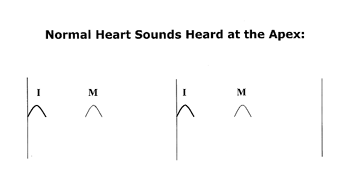
A light, yet long tap is done to create the first heart sound (S1), followed by a lighter tap and one of shorter duration to create the second heart sound (S2), as the closure of the aortic and pulmonic valves (S2) makes a sound that is lighter and shorter than that of the mitral and tricuspid valves upon closure (S1). One must be careful to keep the intervals between S1 and S2 and between S2 and S1 steady and consistent.
Mitral Insufficiency Heard at the Apex
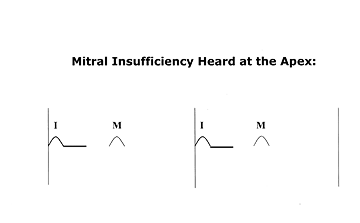
A tap stroke is performed with the index finger to mimic S1 as well as the murmur, followed by a light tap with the middle finger to mimic the normal S2. Note that the murmur follows and does not mask (replace) the S1.
Aortic Insufficiency Heard at the Base
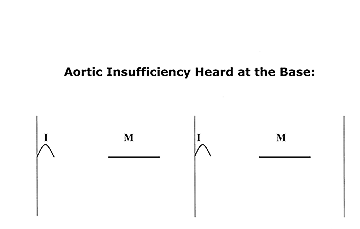
A light tap is made with the index finger to mimic S1, followed by a stroke with the middle finger to mimic the diastolic murmur of aortic insufficiency. Note that in this case the murmur of aortic insufficiency does replace the second heart sound.
Mitral Stenosis Heard at the Apex:
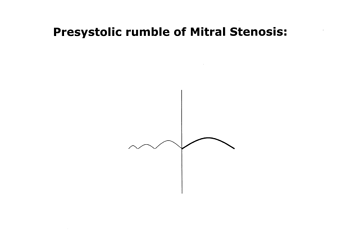
Beginning with the little finger and ending with the index finger, one makes a rapid
succession of four crescendo taps with the little finger (L), ring finger (R),
middle finger (M), index finger (I) to represent the presystolic rumble of mitral stenosis.
The last tap should be strong enough to make the shock of S1 clear.
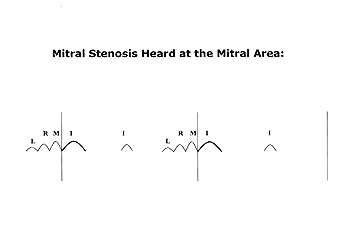
The above is followed with a light tap to represent S2.
Mitral Stenosis and Mitral Insufficiency:
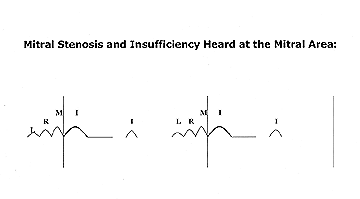
Here there is an additional murmur - on top of the presystolic rumble of mitral stenosis, there is a systolic murmur which can be recreated by transforming the last tap of the presystolic rumble into a tap-stroke which is light and short, and lateral, toward the little finger. This is again followed with a light tap to mimic S2.
Mitral Stenosis, Mitral Insufficiency and Aortic Insufficiency:
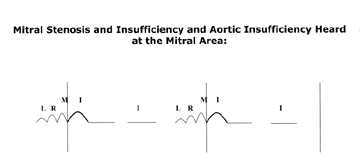
The murmur of aortic insufficiency replaces the second heart sound; so instead of the light tap for S2, a short gentle stroke is made in the lateral direction (toward the thumb) to represent the diastolic murmur of aortic insufficiency.
If the murmur of aortic insufficiency is not intended to replace S2, a tap-stroke is made, also in the lateral direction. Four crescendo taps are made for the presystolic rumble of mitral stenosis and a tap-stroke for the systolic murmur of mitral insufficiency. The lateral movements made for both the systolic and diastolic murmurs are produced best with a rocking motion of the wrist, “first to the ulnar then to the radial side”.
Aortic Stenosis Heard at the Base:
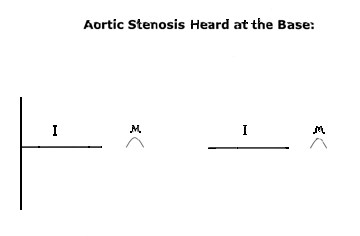
With the nail of the index finger, a firm, long, scratching stroke is made to represent the harsh systolic murmur of aortic stenosis. This is followed by a very light tap made with the middle finger to represent the faint S2.
Mitral and Aortic Insufficiency Heard at the Apex:
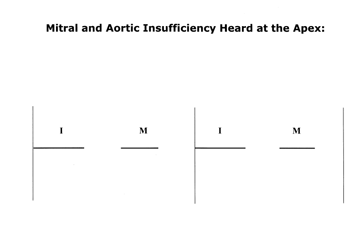
A relatively long stroke is made with the index finger to represent the systolic murmur of mitral insufficiency, followed by a shorter and lighter stroke representing the diastolic murmur of aortic insufficiency. There are no taps made between these two murmurs, as the murmurs replace both S1 and S2.
In aortic insufficiency there is a “pistol-shot” sound that can be heard over the arteries of the extremities. This sound can be recreated by performing a short, sharp tap over the metacarpophalangeal joint of the middle or index finger.
Many other sounds, both physiological and pathological can be imitated using this technique.
Back to E-chocardiography Home Page.

The contents and links on this page were last verified on January 15, 2007.